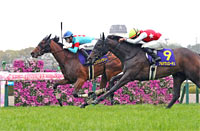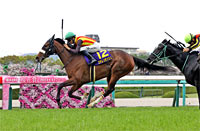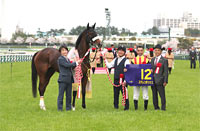Oka Sho (Japanese 1000 Guineas) (G1) - Data Analysis
Top attraction that has propelled many fillies toward historic careers, including in recent years
After achieving her first G1 victory in the 2020 Oka Sho (Japanese 1000 Guineas), Daring Tact won the Yushun Himba (Japanese Oaks) and Shuka Sho, becoming the first ever Triple Crown filly with an unbeaten career record. In addition, 2019 winner Gran Alegria went on to secure three consecutive victories in the 2020 Yasuda Kinen, Sprinters Stakes, Mile Championship, and received the JRA Award for Best Sprinter in the same year. Furthermore, 2018 winner Almond Eye won a total of eight JRA turf G1 races, including the Triple Crown races for fillies, setting a historic record. Oka Sho winners in recent years have not only been active as three-year-olds, but also continued to perform well as older horses. Let’s now analyze some features shared by successful runners in this race based on results over the last 10 years.
Focus on runners coming from the Tulip Sho and runners that performed well last time out
Of the 30 Top 3 finishers over the last 10 years, 18 had contested their previous race in the Tulip Sho. Runners in this group achieved an excellent Top 3 ratio of 39.1%. This year again, we should first focus our attention on runners that are coming straight from the Tulip Sho. [Table 1]
[Table 1] Performance by previous race (last 10 years)
| Previous race |
Performance
[1st-2nd-3rd-4th or lower] |
Win ratio |
Top 2 ratio |
Top 3 ratio |
| Tulip Sho |
5-7-6-28 |
10.9% |
26.1% |
39.1% |
| Race other than Tulip Sho |
5-3-4-120 |
3.8% |
6.1% |
9.1% |
Conversely, among runners that had previously contested a race other than the Tulip Sho, those that had finished 4th or lower in their previous race were all beaten to 4th or lower in the Oka Sho. In other words, we should assess runners that come from a race other than the Tulip Sho based on their finish in the previous race. [Table 2]
[Table 2] Among runners that had previously contested a race other than the Tulip Sho, performance by finish in previous race (last 10 years)
| Finish in previous race |
Performance
[1st-2nd-3rd-4th or lower] |
Win ratio |
Top 2 ratio |
Top 3 ratio |
| 1st |
3-3-3-37 |
6.5% |
13.0% |
19.6% |
| 2nd, 3rd |
2-0-1-34 |
5.4% |
5.4% |
8.1% |
| 4th or lower |
0-0-0-49 |
0% |
0% |
0% |
Sluggish performance by runners that had been poorly favored in previous race
Of the 30 Top 3 finishers over the last 10 years, 29 had been backed as 5th favorite or higher in their previous race. Conversely, runners that had been backed as 6th favorite or lower last time out struggled with a Top 3 ratio of 1.9%. When comparing the previous race of the runners, we should concentrate on favoritism. [Table 3]
[Table 3] Performance by favoritism in previous race (last 10 years)
| Favoritism in previous race |
Performance
[1st-2nd-3rd-4th or lower] |
Win ratio |
Top 2 ratio |
Top 3 ratio |
| 5th favorite or higher |
10-10-9-97 |
7.9% |
15.9% |
23.0% |
| 6th favorite or lower |
0-0-1-51 |
0% |
0% |
1.9% |
Runners with fewer career starts have the edge
Of the 30 Top 3 finishers over the last 10 years, 23 had four or fewer careers starts. Conversely, runners with five or more careers starts struggled with a Top 3 ratio of 6.8%. This suggests we should lower our expectations of runners with five or more career starts. [Table 4]
[Table 4] Performance by total career starts (last 10 years)
| Total career starts |
Performance
[1st-2nd-3rd-4th or lower] |
Win ratio |
Top 2 ratio |
Top 3 ratio |
| 4 or fewer |
8-8-7-52 |
10.7% |
21.3% |
30.7% |
| 5 or more |
2-2-3-96 |
1.9% |
3.9% |
6.8% |
Among runners with five or more career starts, those without experience of “finishing in the Top 4 of a graded 1,600m JRA race held in the same year” had a Top 3 ratio of only 2.9%. The last runner in this group to finish in the Top 3 of the Oka Sho was 2013 third-place finisher Princess Jack. When comparing runners with five or more career starts, we should focus on their record in mile-long graded races since the start of the year. [Table 5]
[Table 5] Among runners with five or more career starts, performance by experience of finishing in the Top 4 of a “graded 1,600m JRA race held in the same year” (last 10 years)
| Experience |
Performance
[1st-2nd-3rd-4th or lower] |
Win ratio |
Top 2 ratio |
Top 3 ratio |
| Yes |
2-2-1-30 |
5.7% |
11.4% |
14.3% |
| No |
0-0-2-66 |
0% |
0% |
2.9% |
Stable record a key point
Of the 30 Top 3 finishers over the last 10 years, 28 had no experience of finishing 2nd or lower except in a JRA newcomer or graded race. Conversely, runners with such experience struggled with a Top 3 ratio of 2.5%. In other words, we should resolutely lower our expectations of runners that have been defeated in maiden class, 1-win class, or open-class races. [Table 6]
[Table 6] Performance by experience of finishing 2nd or lower except in JRA newcomer or graded race (last 10 years)
| Experience |
Performance
[1st-2nd-3rd-4th or lower] |
Win ratio |
Top 2 ratio |
Top 3 ratio |
| Yes |
0-1-1-77 |
0% |
1.3% |
2.5% |
| No |
10-9-9-71 |
10.1% |
19.2% |
28.3% |
Solid performance by runners with strong aptitude for the course
Of the 30 Top 3 finishers over the last 10 years, 18 had experience of finishing in the Top 3 of “a 1,600m graded turf race held at Hanshin Racecourse.” Conversely, runners without this experience struggled with a Top 3 ratio of 8.8%. This suggests we should raise our expectations of runners that have performed well in 1,600m turf races at Hanshin Racecourse, such as the Hanshin Juvenile Fillies or the Tulip Sho. [Table 7]
[Table 7] Performance by experience of finishing in Top 3 of “1,600m graded turf race held at Hanshin Racecourse” (last 10 years)
| Experience |
Performance
[1st-2nd-3rd-4th or lower] |
Win ratio |
Top 2 ratio |
Top 3 ratio |
| Yes |
6-7-5-23 |
14.6% |
31.7% |
43.9% |
| No |
4-3-5-125 |
2.9% |
5.1% |
8.8% |
In addition, among runners without experience of finishing in the Top 3 of “a 1,600m graded turf race held at Hanshin Racecourse,” runners without experience of finishing 1st in “a JRA open-class race” held in January or February of the same year, had a Top 3 ratio of only 2.9%. Incidentally, if we limit our analysis to the last seven years, the performance of runners in this group was [0-0-1-70], with their success ratios dropping even further (Top 3 ratio of 1.4%). When comparing runners that have not performed well in a 1,600m graded turf race held at Hanshin Racecourse, we should focus on runners that have won a graded race or open-class race held since the start of the year but prior to the Tulip Sho. [Table 8]
[Table 8] Among runners without experience of finishing in the Top 3 of “a 1,600m graded turf race held at Hanshin Racecourse,” performance by experience of winning “a JRA open-class race” held in January or February of the same year (last 10 years)
| Experience |
Performance
[1st-2nd-3rd-4th or lower] |
Win ratio |
Top 2 ratio |
Top 3 ratio |
| Yes |
4-3-2-26 |
11.4% |
20.0% |
25.7% |
| No |
0-0-3-99 |
0% |
0% |
2.9% |
Seek out the winner!
Lighter horses struggle to win
The last seven winners all weighed in at 464kg or more in their previous race. This suggests the likelihood of lighter horses securing a victory is low. Other shared features among the seven winners were that they had been backed as 3rd favorite or higher in their previous race, and that they had no experience of being defeated except in a JRA newcomer or graded race. In other words, we should also consider the trends in Table 3 and Table 6. [Table 9]
[Table 9] Winners’ performance by body weight in previous race, favoritism in previous race, and record except in JRA newcomer or graded race (last seven years)
| Year |
Winner |
Body weight in previous race |
Favoritism in previous race |
Record except in JRA newcomer or graded race |
| 2014 |
Harp Star |
476kg |
1st favorite |
No such race entered |
| 2015 |
Let’s Go Donki |
468kg |
2nd favorite |
No such race entered |
| 2016 |
Jeweler |
498kg |
1st favorite |
No such race entered |
| 2017 |
Reine Minoru |
468kg |
1st favorite |
No such race entered |
| 2018 |
Almond Eye |
464kg |
1st favorite |
1 start, 1 win |
| 2019 |
Gran Alegria |
482kg |
1st favorite |
No such race entered |
| 2020 |
Daring Tact |
466kg |
3rd favorite |
1 start, 1 win |
(Masaya Ibuki)
|




















